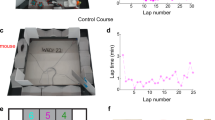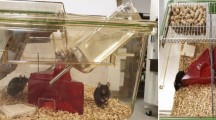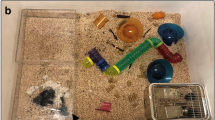Abstract
The beneficial effects of environment and social support during disease recovery in humans are widely accepted. Because laboratory mice are social animals and are highly motivated to interact with each other and with their environment, it is very likely that environmental and social factors are also beneficial to their recovery from experimental interventions or spontaneous diseases. The beneficial effects of enriched environments have been particularly well analyzed in the field of brain disorders, but several studies suggest that positive social contact and a complex and familiar environment may also support recovery from injury, from invasive procedures such as surgery or from spontaneously occurring diseases. The author reviews relevant publications on the effects of environment and social housing on recovery from disease or surgery in laboratory mice and other rodents. She concludes that in addition to promoting animal welfare, provision of optimal experimental housing conditions might also contribute to the clinical relevance of preclinical animal models by more closely simulating the environmental and social characteristics of disease recovery in humans.
This is a preview of subscription content, access via your institution
Access options
Subscribe to this journal
We are sorry, but there is no personal subscription option available for your country.
Buy this article
- Purchase on Springer Link
- Instant access to full article PDF
Prices may be subject to local taxes which are calculated during checkout
Similar content being viewed by others
References
Ulrich, R.S. View through a window may influence recovery from surgery. Science 224, 420–421 (1984).
House, J.S. Social isolation kills, but how and why? Psychosom. Med. 63, 273–274 (2001).
Flor, H., Fydrich, T. & Turk, D.C. Efficacy of multidisciplinary pain treatment centers: a meta-analytic review. Pain 49, 221–230 (1992).
de Wied, M. & Verbaten, M.N. Affective pictures processing, attention, and pain tolerance. Pain 90, 163–172 (2001).
Bonifazi, M. et al. Changes in salivary cortisol and corticosteroid receptor-alpha mRNA expression following a 3-week multidisciplinary treatment program in patients with fibromyalgia. Psychoneuroendocrinology 31, 1076–1086 (2006).
Olsson, I.A.S. & Westlund, K. More than numbers matter: The effect of social factors on behaviour and welfare of laboratory rodents and non-human primates. Appl. Anim. Behav. Sci. 103, 229–254 (2007).
Meijer, M.K. et al. The effect of routine experimental procedures on physiological parameters in mice kept under different husbandry conditions. Anim. Welf. 15, 31–38 (2006).
Bartolomucci, A. et al. Individual housing induces altered immunoendocrine responses to psychological stress in male mice. Psychoneuroendocrinology 28, 540–558 (2003).
Rosenzweig, M.R. & Bennett, E.L. Psychobiology of plasticity: effects of training and experience on brain and behavior. Behav. Brain Res. 78, 57–65 (1996).
Nithianantharajah, J. & Hannan, A.J. Enriched environments, experience-dependent plasticity and disorders of the nervous system. Nat. Rev. Neurosci. 7, 697–709 (2006).
Xie, H. et al. Enrichment-induced exercise to quantify the effect of different housing conditions: a tool to standardize enriched environment protocols. Behav. Brain Res. 249, 81–89 (2013).
Girbovan, C. & Plamondon, H. Environmental enrichment in female rodents: considerations in the effects on behavior and biochemical markers. Behav. Brain Res. 253, 178–190 (2013).
Olsson, I.A. & Dahlborn, K. Improving housing conditions for laboratory mice: a review of ″environmental enrichment″. Lab. Anim. 36, 243–270 (2002).
Toth, L.A., Kregel, K., Leon, L. & Musch, T.I. Environmental enrichment of laboratory rodents: the answer depends on the question. Comp. Med. 61, 314–321 (2011).
Smith, A.L. & Corrow, D.J. Modifications to husbandry and housing conditions of laboratory rodents for improved wellbeing. ILAR J. 46, 140–147 (2005).
Pang, T.Y. & Hannan, A.J. Enhancement of cognitive function in models of brain disease through environmental enrichment and physical activity. Neuropharmacology 64, 515–528 (2013).
Begenisic, T. et al. Environmental enrichment decreases GABAergic inhibition and improves cognitive abilities, synaptic plasticity, and visual functions in a mouse model of Down syndrome. Front. Cell. Neurosci. 5, 29 (2011).
Restivo, L. et al. Enriched environment promotes behavioral and morphological recovery in a mouse model for the fragile X syndrome. Proc. Natl. Acad. Sci. USA 102, 11557–11562 (2005).
Dhanushkodi, A. & Shetty, A.K. Is exposure to enriched environment beneficial for functional post-lesional recovery in temporal lobe epilepsy? Neurosci. Biobehav. Rev. 32, 657–674 (2008).
Goldberg, N.R., Haack, A.K. & Meshul, C.K. Enriched environment promotes similar neuronal and behavioral recovery in a young and aged mouse model of Parkinson′s disease. Neuroscience 172, 443–452 (2011).
Faherty, C.J., Raviie Shepherd, K., Herasimtschuk, A. & Smeyne, R.J. Environmental enrichment in adulthood eliminates neuronal death in experimental Parkinsonism. Brain Res. Mol. Brain Res. 134, 170–179 (2005).
Passineau, M.J., Green, E.J. & Dietrich, W.D. Therapeutic effects of environmental enrichment on cognitive function and tissue integrity following severe traumatic brain injury in rats. Exp. Neurol. 168, 373–384 (2001).
Gobbo, O.L. & O'Mara, S.M. Impact of enriched-environment housing on brain-derived neurotrophic factor and on cognitive performance after a transient global ischemia. Behav. Brain Res. 152, 231–241 (2004).
Biernaskie, J. & Corbett, D. Enriched rehabilitative training promotes improved forelimb motor function and enhanced dendritic growth after focal ischemic injury. J. Neurosci. 21, 5272–5280 (2001).
Belayev, A. et al. Enriched environment delays the onset of hippocampal damage after global cerebral ischemia in rats. Brain Res. 964, 121–127 (2003).
Seo, J.H. et al. Environmental enrichment synergistically improves functional recovery by transplanted adipose stem cells in chronic hypoxic-ischemic brain injury. Cell Transplant. 22, 1553–1568 (2013).
Kiecolt-Glaser, J.K., McGuire, L., Robles, T.F. & Glaser, R. Emotions, morbidity, and mortality: new perspectives from psychoneuroimmunology. Annu. Rev. Psychol. 53, 83–107 (2002).
Broadbent, E. & Koschwanez, H.E. The psychology of wound healing. Curr. Opin. Psychiatry 25, 135–140 (2012).
Kingston, S.G. & Hoffman-Goetz, L. Effect of environmental enrichment and housing density on immune system reactivity to acute exercise stress. Physiol. Behav. 60, 145–150 (1996).
Schloesser, R.J., Lehmann, M., Martinowich, K., Manji, H.K. & Herkenham, M. Environmental enrichment requires adult neurogenesis to facilitate the recovery from psychosocial stress. Mol. Psychiatry 15, 1152–1163 (2010).
Llorens-Martín, M., Tejeda, G.S. & Trejo, J.L. Antidepressant and proneurogenic influence of environmental enrichment in mice: protective effects vs recovery. Neuropsychopharmacology 36, 2460–2468 (2011).
Hattori, S. et al. Enriched environments influence depression-related behavior in adult mice and the survival of newborn cells in their hippocampi. Behav. Brain Res. 180, 69–76 (2007).
Vitalo, A. et al. Nest making and oxytocin comparably promote wound healing in isolation reared rats. PLoS ONE 4, e5523 (2009).
Tall, J.M. Housing supplementation decreases the magnitude of inflammation-induced nociception in rats. Behav. Brain Res. 197, 230–233 (2009).
Gabriel, A.F., Marcus, M.A., Honig, W.M., Helgers, N. & Joosten, E.A. Environmental housing affects the duration of mechanical allodynia and the spinal astroglial activation in a rat model of chronic inflammatory pain. Brain Res. 1276, 83–90 (2009).
Arndt, S.S. et al. Individual housing of mice–impact on behaviour and stress responses. Physiol. Behav. 97, 385–393 (2009).
Bartolomucci, A., Parmigiani, S., Gioiosa, L., Ceresini, G. & Palanza, P. Effects of housing social context on emotional behaviour and physiological responses in female mice. Scand. J. Lab. Anim. Sci. 36, 87–95 (2009).
D′Arbe, M., Einstein, R. & Lavidis, N.A. Stressful animal housing conditions and their potential effect on sympathetic neurotransmission in mice. Am. J. Physiol. Regul. Integr. Comp. Physiol. 282, R1422–R1428 (2002).
Späni, D., Arras, M., Konig, B. & Rulicke, T. Higher heart rate of laboratory mice housed individually vs in pairs. Lab. Anim. 37, 54–62 (2003).
Ferrari, P.F., Palanza, P., Parmigiani, S. & Rodgers, R.J. Interindividual variability in Swiss male mice: relationship between social factors, aggression, and anxiety. Physiol. Behav. 63, 821–827 (1998).
Voikar, V., Polus, A., Vasar, E. & Rauvala, H. Long-term individual housing in C57BL/6J and DBA/2 mice: assessment of behavioral consequences. Genes Brain Behav. 4, 240–252 (2005).
Kwak, C., Lee, S.H. & Kaang, B.K. Social isolation selectively increases anxiety in mice without affecting depression-like behavior. Korean J. Physiol. Pharmacol. 13, 357–360 (2009).
Stub, C., Ritskes-Hoitinga, M., Olsen, A.K., Krohn, T.C. & Hansen, A.K. Fluctuating asymmetry in relation to single housing versus group housing in three inbred mouse strains. Scand. J. Lab. Anim. Sci. 31, 245–249 (2004).
Andrade, C.S. & Guimarães, F.S. Anxiolytic-like effect of group housing on stress-induced behavior in rats. Depress. Anxiety 18, 149–152 (2003).
Uchino, B.N., Cacioppo, J.T. & Kiecolt-Glaser, J.K. The relationship between social support and physiological processes: a review with emphasis on underlying mechanisms and implications for health. Psychol. Bull. 119, 488–531 (1996).
Karelina, K. & DeVries, A.C. Modeling social influences on human health. Psychosom. Med. 73, 67–74 (2011).
DeVries, A.C., Craft, T.K., Glasper, E.R., Neigh, G.N. & Alexander, J.K. 2006 Curt P. Richter award winner: Social influences on stress responses and health. Psychoneuroendocrinology 32, 587–603 (2007).
Weil, Z.M. et al. Social isolation potentiates cell death and inflammatory responses after global ischemia. Mol. Psychiatry 13, 913–915 (2008).
Venna, V.R., Xu, Y., Doran, S.J., Patrizz, A. & McCullough, L.D. Social interaction plays a critical role in neurogenesis and recovery after stroke. Transl. Psychiatry 4, e351 (2014).
Karelina, K. et al. Social isolation alters neuroinflammatory response to stroke. Proc. Natl. Acad. Sci. USA 106, 5895–5900 (2009).
Karelina, K., Norman, G.J., Zhang, N. & DeVries, A.C. Social contact influences histological and behavioral outcomes following cerebral ischemia. Exp. Neurol. 220, 276–282 (2009).
Craft, T.K. et al. Social interaction improves experimental stroke outcome. Stroke 36, 2006–2011 (2005).
Nakagawa-Toyama, Y., Zhang, S. & Krieger, M. Dietary manipulation and social isolation alter disease progression in a murine model of coronary heart disease. PLoS ONE 7, e47965 (2012).
Palermo-Neto, J., Fonseca, E.S., Quinteiro-Filho, W.M., Correia, C.S. & Sakai, M. Effects of individual housing on behavior and resistance to Ehrlich tumor growth in mice. Physiol. Behav. 95, 435–440 (2008).
Larauche, M., Gourcerol, G., Million, M., Adelson, D.W. & Tache, Y. Repeated psychological stress-induced alterations of visceral sensitivity and colonic motor functions in mice: influence of surgery and postoperative single housing on visceromotor responses. Stress 13, 343–354 (2010).
Pham, T.M. et al. Housing environment influences the need for pain relief during post-operative recovery in mice. Physiol. Behav. 99, 663–668 (2010).
Van Loo, P.L. et al. Impact of ′living apart together′ on postoperative recovery of mice compared with social and individual housing. Lab. Anim. 41, 441–455 (2007).
Jirkof, P., Cesarovic, N., Rettich, A., Fleischmann, T. & Arras, M. Individual housing of female mice: influence on postsurgical behaviour and recovery. Lab. Anim. 46, 325–334 (2012).
Detillion, C.E., Craft, T.K., Glasper, E.R., Prendergast, B.J. & DeVries, A.C. Social facilitation of wound healing. Psychoneuroendocrinology 29, 1004–1011 (2004).
Levine, J.B. et al. Isolation rearing impairs wound healing and is associated with increased locomotion and decreased immediate early gene expression in the medial prefrontal cortex of juvenile rats. Neuroscience 151, 589–603 (2008).
Glasper, E.R. & Devries, A.C. Social structure influences effects of pair-housing on wound healing. Brain Behav. Immun. 19, 61–68 (2005).
Van Loo, P.L.P., Kruitwagen, C.L.J.J., Van Zutphen, L.F.M., Koolhaas, J.M. & Baumans, V. Modulation of aggression in male mice: Influence of cage cleaning regime and scent marks. Anim. Welf. 9, 281–295 (2000).
Fitchett, A.E., Barnard, C.J. & Cassaday, H.J. There′s no place like home: cage odours and place preference in subordinate CD-1 male mice. Physiol. Behav. 87, 955–962 (2006).
Hurst, J.L. et al. Individual recognition in mice mediated by major urinary proteins. Nature 414, 631–634 (2001).
Gray, S. & Hurst, J.L. The effects of cage cleaning on aggression within groups of male laboratory mice. Anim. Behav. 49, 821–826 (1995).
Brennan, P. How mice make their mark. Nature 414, 590–591 (2001).
Burn, C.C., Peters, A. & Mason, G.J. Acute effects of cage cleaning at different frequencies on laboratory rat behavior and welfare. Anim. Welf. 15, 161–171 (2006).
Marques, J.M., Olsson, I.A., Ogren, S.O. & Dahlborn, K. Evaluation of exploration and risk assessment in pre-weaning mice using the novel cage test. Physiol. Behav. 93, 139–147 (2008).
Pardon, M.C. et al. Social threat and novel cage stress induced sustained extracellular-regulated kinase1/2 (ERK1/2) phosphorylation but differential modulation of brain-derived neurotrophic factor (BDNF) expression in the hippocampus of NMRI mice. Neuroscience 132, 561–574 (2005).
Misslin, R., Herzog, F., Koch, B. & Ropartz, P. Effects of isolation, handling and novelty on the pituitary–adrenal response in the mouse. Psychoneuroendocrinology 7, 217–221 (1982).
Tuli, J.S., Smith, J.A. & Morton, D.B. Stress measurements in mice after transportation. Lab. Anim. 29, 132–138 (1995).
Jirkof, P., Cesarovic, N., Rettich, A. & Arras, M. Housing of female mice in a new environment and its influence on postsurgical behaviour and recovery. Appl. Anim. Behav. Sci. 148, 209–217 (2013).
Schallert, T., Woodlee, M.T. & Fleming, S.M. Experimental focal ischemic injury: behavior-brain interactions and issues of animal handling and housing. ILAR J. 44, 130–143 (2003).
Reber, S.O. et al. Mucosal immunosuppression and epithelial barrier defects are key events in murine psychosocial stress-induced colitis. Brain Behav. Immun. 25, 1153–1161 (2011).
Haemisch, A. & Gärtner, K. Effects of cage enrichment on territorial aggression and stress physiology in male laboratory mice. Acta Physiol. Scand. Suppl. 640, 73–76 (1997).
Van Loo, P.L., Van Zutphen, L.F. & Baumans, V. Male management: Coping with aggression problems in male laboratory mice. Lab. Anim. 37, 300–313 (2003).
Author information
Authors and Affiliations
Corresponding author
Ethics declarations
Competing interests
The author declares no competing financial interests.
Rights and permissions
About this article
Cite this article
Jirkof, P. Effects of experimental housing conditions on recovery of laboratory mice. Lab Anim 44, 65–70 (2015). https://doi.org/10.1038/laban.662
Received:
Accepted:
Published:
Issue Date:
DOI: https://doi.org/10.1038/laban.662



